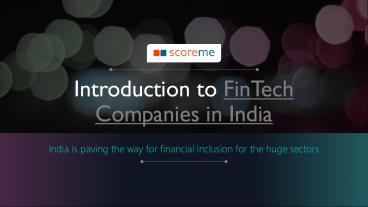Introduction to Fintech companies in India - PowerPoint PPT Presentation
Title:
Introduction to Fintech companies in India
Description:
With the rapid advent of “digital” in India since the past few years, it has increasingly become easier to access financial services. A widely used term in the new digital age, fintech, has contributed to the changing patterns of consumer banking. Orignal Source - – PowerPoint PPT presentation
Number of Views:1318
Title: Introduction to Fintech companies in India
1
Introduction to FinTech Companies in India
- India is paving the way for financial inclusion
for the huge sectors
2
- With the rapid advent of digital in India since
the past few years, it has increasingly become
easier to access financial services. A widely
used term in the new digital age, fintech, has
contributed to the changing patterns of consumer
banking. Around the year 2015, India saw a boom
in technology adoption in financial services.
According to Research and Markets, in 2019,
the Fintech companies in India was valued at Rs
1,920 Bn and is expected to reach Rs 6,207 Bn by
2025, expanding at a CAGR of 22.7. - Even at an early adoption stage, fintech in India
is paving the way for financial inclusion for the
huge sector of unbanked and under banked
population by weeding out challenges like high
cost of traditional banking services. It is
serving as a catalyst in the payments network,
which is proving advantageous for small
borrowers, SMEs, MSMEs, rural entrepreneurs,
self-help groups and end users. Fintech has a
critical role to play in breaking barriers of
high-cost traditional banking.
3
- The Fintech Ecosystem
- Let us deconstruct the various players in a
fintech ecosystem and how they are inter-linked
to Fintech solution providers. - Investors Venture Capitals, angel investors and
private equity houses are considering fintech
providers as the next golden goose. - Traditional financial institutions Banks and
financial service providers are devising ways to
collaborate with fintechs to leverage the
technological advent as well as to reduce cost of
operations - Government and regulators Suitable laws protect
the end users as well as lay the guidelines for
fintechs to operate within set parameters - Universities and research institutions The
acute shortage of talented and equipped workforce
is being met by institutes with a curriculum that
focuses on fintech companies in India - Incubators Several established companies are
setting up incubators for fintechs in India to
experiment and develop their services. - Users The end user remains the most important
cog of the fintech wheel. The increased adoption
and acceptance by Indians are paving the way for
more fintech companies in india.
4
- While the rural population has been unwilling to
accept fintech due to lack of exposure, urban
India is aggressively adopting it. However, in
the last few years there have been Government
initiatives like Aadhaar for eKYC, UPI for
payments, e-wallets for transactions,
sound-wave-based payments for rural consumers
which have helped bridge a huge gap. The adoption
of these innovations highlights the fact that
India is building a cost-effective, large-value,
fintech-driven ecosystem that is focused on urban
as well as rural segments. Fintechs companies in
India have been transforming the narrative for
financial inclusion by focusing on cost of
financial services, accessibility of services,
information incongruence, and lack of verifiable
ID.
FinTech Innovations in India
- Payment Services Payments are a lot easier now.
You can have a multitude of payment wallets
without the lengthy procedure of opening a bank
account. All you need is a smartphone and a
mobile sim and you can buy almost everything
within the wallet limit. Players like PayTM,
Freecharge and MobiKwik have completely disrupted
the Indian payment scenario. Physical wallets are
no more a necessity when you go out. Just carry
your phone and scan away!
5
- Digital Lending Fintech innovation is being
leveraged to create a space in lending.
Traditionally, customers have to go through long
cycles and paperwork to get a loan. Prominent
companies like Union Bank of India, Profectus
Capital, Bank of India, UCO Bank, SIDBI etc. are
changing the age-old method. Customers without
steady employment, bank account statements can
also avail loans now. Fintech is opening up a
host of lending models such as flow-based,
vertical-based and ecosystem-based lending. - Insurance Another sector going the paperless
way is Insurance. Aggregators like Policybazaar
and Coverfox have emerged which help consumers
choose among host of service providers by
comparing their offerings and purchase the most
suitable one. - Savings Wealth Management Fintechs like
Scripbox and Funds India help individuals save
and invest their money. These platforms provide
comparable options to choose from. - Remittances Oxigen and Payworld are among the
notable remittance platforms which have made
inward and outward remittances simple and cost
effective. - Point-of-Sale Fintechs in this segment provide
card swipe machines to enable cashless payments.
Demonetization has given rise to new players like
Mswipe, PineLabs, ICICI Merchant Services in this
segment which has made the market competitive.
6
- How are FinTechs companies in India reshaping the
financial services landscape?
- The topmost barrier to traditional banking is
high cost which has left the larger chunk of
population unbanked or underbanked. Fintechs are
here to disrupt that by eliminating expensive
physical networks, outdated legacy operations, IT
systems and creating a lean operating model. - The traditional banking ecosystem has been very
homogenous with almost similar offerings and
service charges. Fintechs provide a scope of
diversifying the services and personalizing to
cater to all strata. - The fintech companies in india has developed
advance methods for risk assessment leveraging
emerging technologies such as Blockchain,
Artificial Intelligence and Big Data Analytics.
The credit requirement scenario can be changed to
penetrate into remote areas. - Fintech innovation aims to create superior
financial products, enhance customer experience
and increase transparency.
Original Source Fintech Companies In India
7
THANK YOU!
- FOR
- READING































